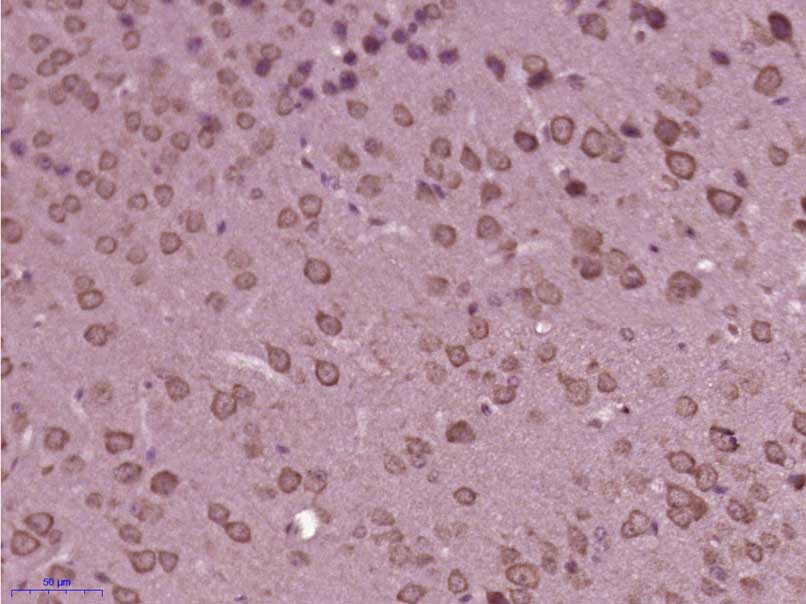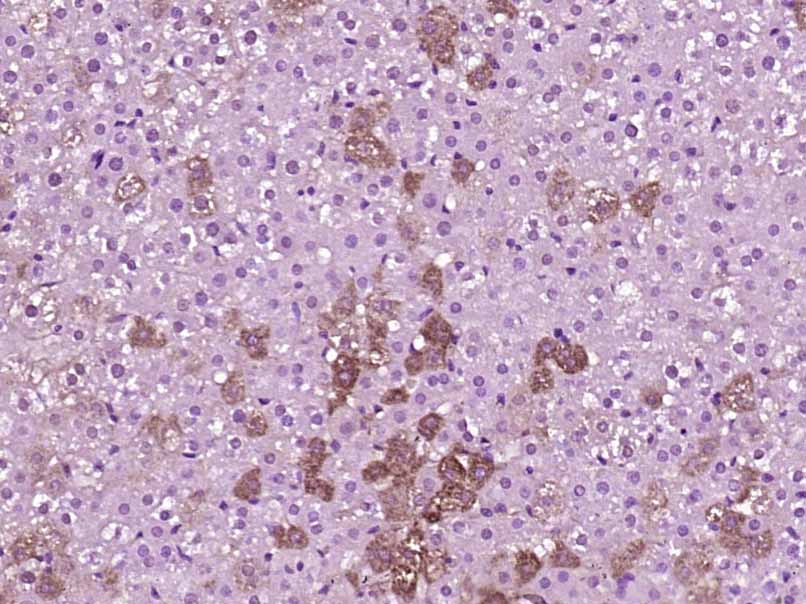
Rabbit Anti-PLEKHG5 antibody
PKHG5_HUMAN; Pleckstrin homology domain-containing family G member 5; PH domain-containing family G member 5; Guanine nucleotide exchange factor 720; GEF720.
View History [Clear]
Details
Product Name PLEKHG5 Chinese Name 凋亡诱导受体PLEKHG5抗体 Alias PKHG5_HUMAN; Pleckstrin homology domain-containing family G member 5; PH domain-containing family G member 5; Guanine nucleotide exchange factor 720; GEF720. Research Area Chromatin and nuclear signals Signal transduction G protein-coupled receptor G protein signal Immunogen Species Rabbit Clonality Polyclonal React Species Mouse, Rat, (predicted: Human, Dog, Pig, Cow, Horse, Rabbit, ) Applications ELISA=1:5000-10000 IHC-P=1:100-500 IHC-F=1:100-500 ICC=1:100-500 IF=1:100-500 (Paraffin sections need antigen repair)
not yet tested in other applications.
optimal dilutions/concentrations should be determined by the end user.Theoretical molecular weight 116kDa Cellular localization cytoplasmic Form Liquid Concentration 1mg/ml immunogen KLH conjugated synthetic peptide derived from human PLEKHG5: 951-1062/1062 Lsotype IgG Purification affinity purified by Protein A Buffer Solution 0.01M TBS(pH7.4) with 1% BSA, 0.03% Proclin300 and 50% Glycerol. Storage Shipped at 4℃. Store at -20 °C for one year. Avoid repeated freeze/thaw cycles. Attention This product as supplied is intended for research use only, not for use in human, therapeutic or diagnostic applications. PubMed PubMed Product Detail This gene encodes a protein that activates the nuclear factor kappa B (NFKB1) signaling pathway. Mutations in this gene are associated with autosomal recessive distal spinal muscular atrophy. Multiple transcript variants encoding different isoforms have been found for this gene. [provided by RefSeq, May 2012]
Function:
Guanine nucleotide exchange factor that activates RHOA and maybe the NF-kappa-B signaling pathway. Involved in the control of neuronal cell differentiation. Plays a role in angiogenesis through regulation of endothelial cells chemotaxis.
Subunit:
Interacts with GIPC1/synectin and RHOA.
Subcellular Location:
Cytoplasm. Cytoplasm, perinuclear region. Cell junction. Cell projection, lamellipodium. Note=Predominantly cytoplasmic, however when cells are stimulated found in perinuclear regions. Localized at cell-cell junctions in quiescent endothelial cells, it relocalizes to cytoplasmic vesicle and the leading edge of lamellipodia in migrating endothelial cells.
Tissue Specificity:
Predominantly expressed in the peripheral nervous system and brain. Highest expression is observed in heart, lung, kidney, testis and moderate expression is present in spleen, pancreas, skeletal muscle, ovary and liver. Weakly expressed in glioblastoma (GBM) cell lines.
DISEASE:
Distal spinal muscular atrophy, autosomal recessive, 4 (DSMA4) [MIM:611067]: A neuromuscular disorder. Distal spinal muscular atrophy, also known as distal hereditary motor neuronopathy, represents a heterogeneous group of neuromuscular disorders caused by selective degeneration of motor neurons in the anterior horn of the spinal cord, without sensory deficit in the posterior horn. The overall clinical picture consists of a classical distal muscular atrophy syndrome in the legs without clinical sensory loss. The disease starts with weakness and wasting of distal muscles of the anterior tibial and peroneal compartments of the legs. Later on, weakness and atrophy may expand to the proximal muscles of the lower limbs and/or to the distal upper limbs. DSMA4 is characterized by childhood onset, generalized muscle weakness and atrophy with denervation and normal sensation. Bulbar symptoms and pyramidal signs are absent. Note=The disease is caused by mutations affecting the gene represented in this entry.
Charcot-Marie-Tooth disease, recessive, intermediate type, C (CMTRIC) [MIM:615376]: A form of Charcot-Marie-Tooth disease, a disorder of the peripheral nervous system, characterized by progressive weakness and atrophy, initially of the peroneal muscles and later of the distal muscles of the arms. Recessive intermediate forms of Charcot-Marie-Tooth disease are characterized by clinical and pathologic features intermediate between demyelinating and axonal peripheral neuropathies, and motor median nerve conduction velocities ranging from 25 to 45 m/sec. Note=The disease is caused by mutations affecting the gene represented in this entry.
Similarity:
Contains 1 DH (DBL-homology) domain.
Contains 1 PH domain.
SWISS:
O94827
Gene ID:
57449
Database links:Entrez Gene: 57449 Human
Entrez Gene: 269608 Mouse
Omim: 611101 Human
SwissProt: O94827 Human
SwissProt: Q66T02 Mouse
Unigene: 284232 Human
Unigene: 332102 Mouse
Unigene: 486442 Mouse
Unigene: 20730 Rat
Product Picture
Bought notes(bought amounts latest0)
No one bought this product
User Comment(Total0User Comment Num)
- No comment




 +86 571 56623320
+86 571 56623320
 +86 18668110335
+86 18668110335

